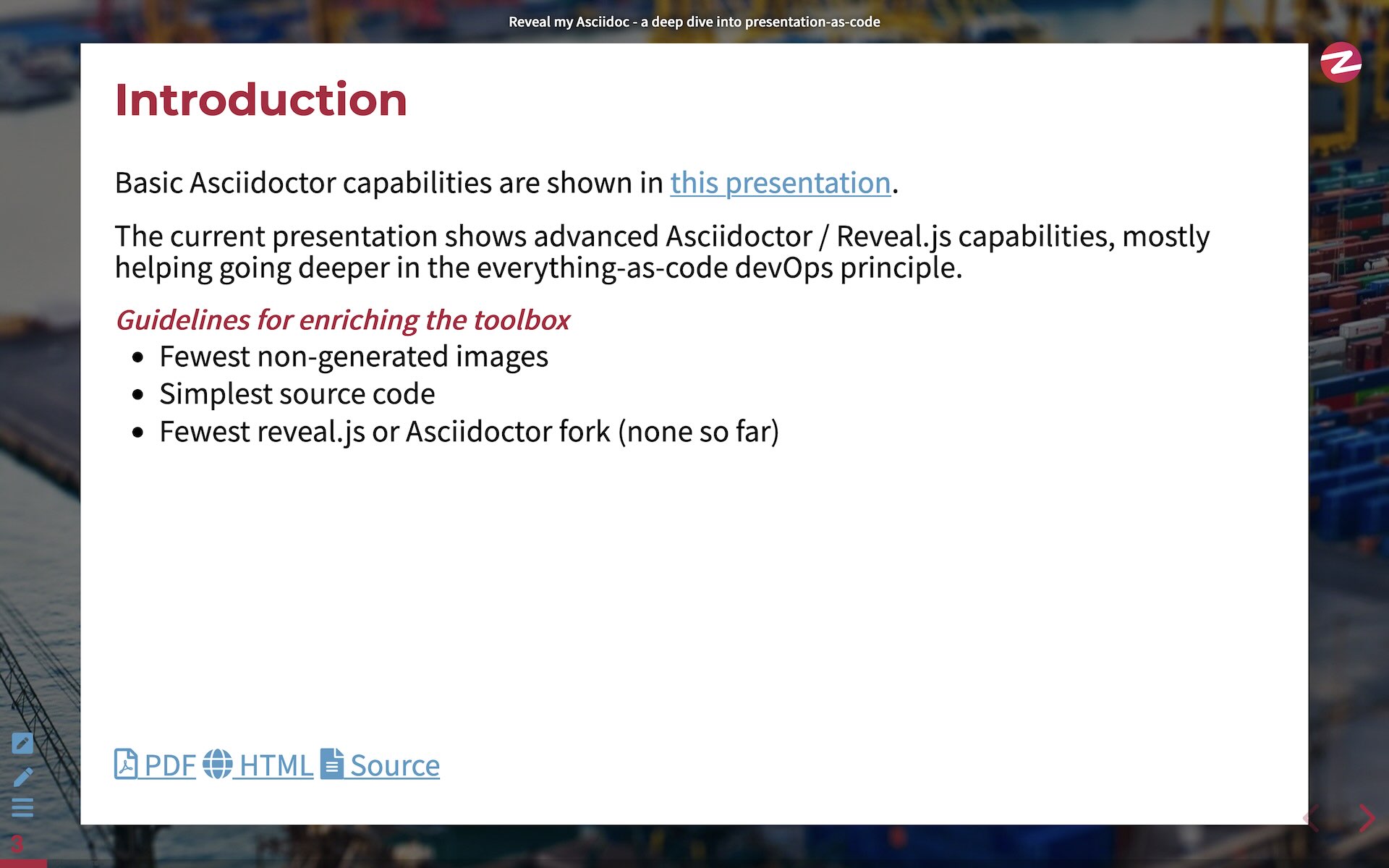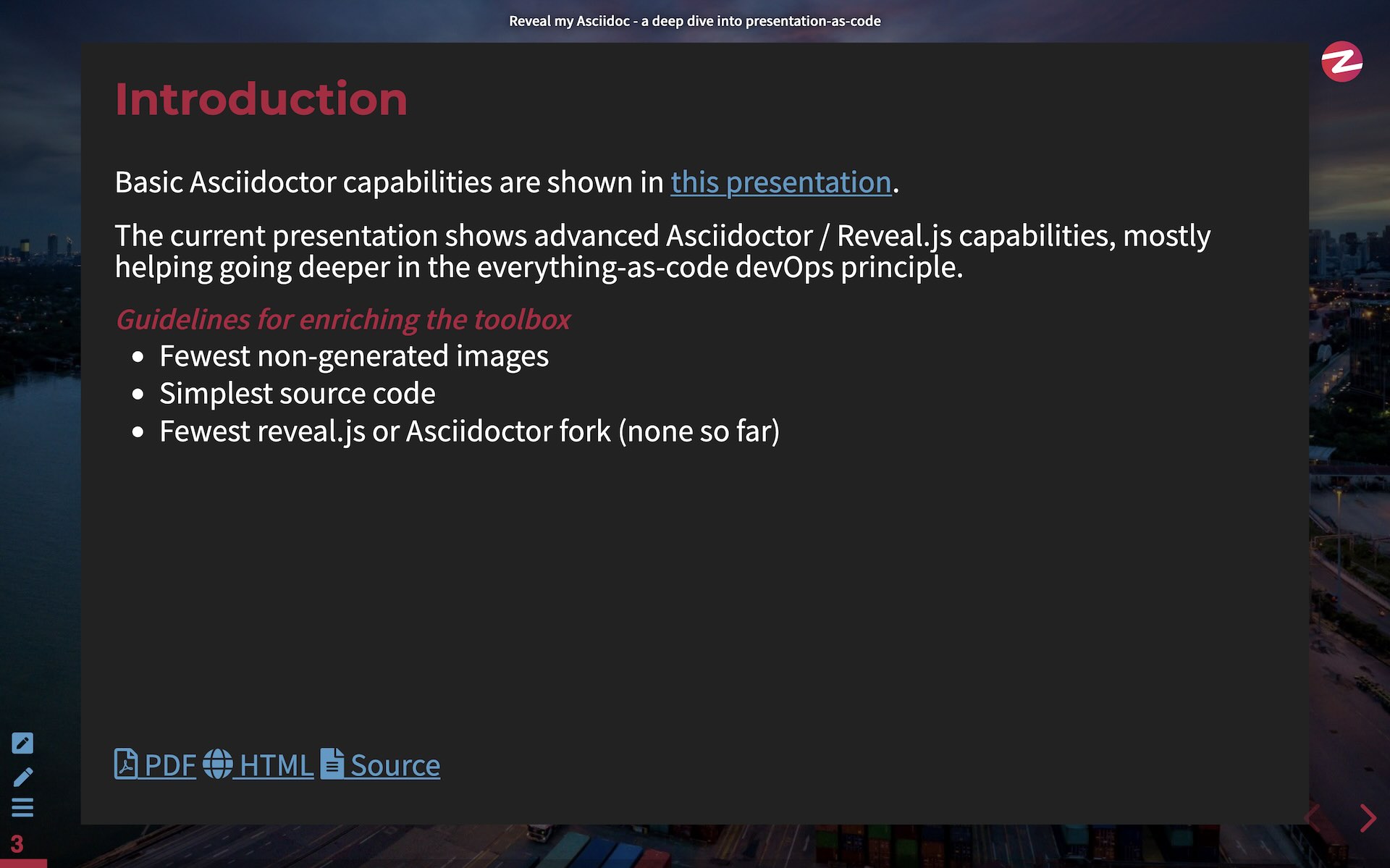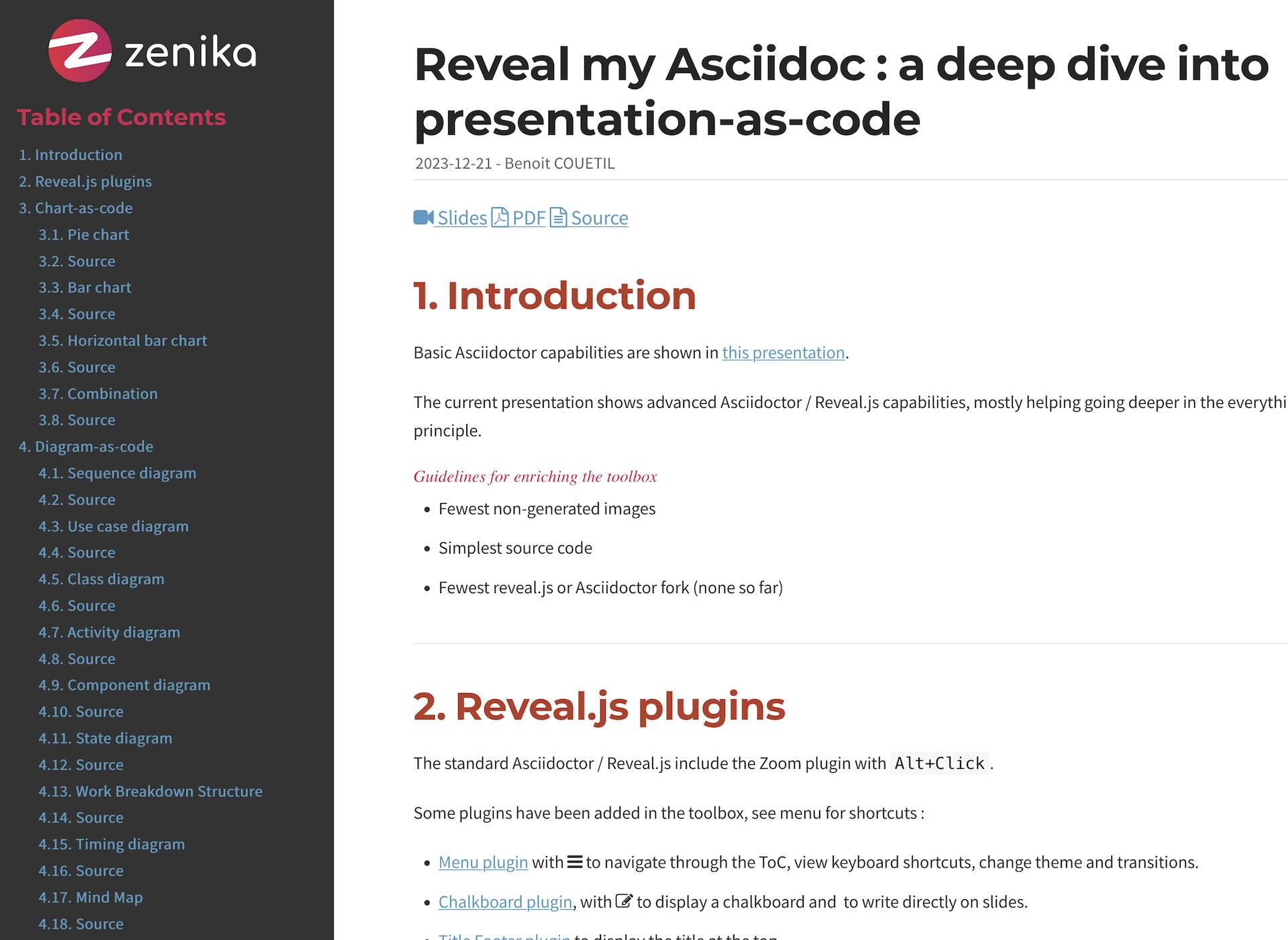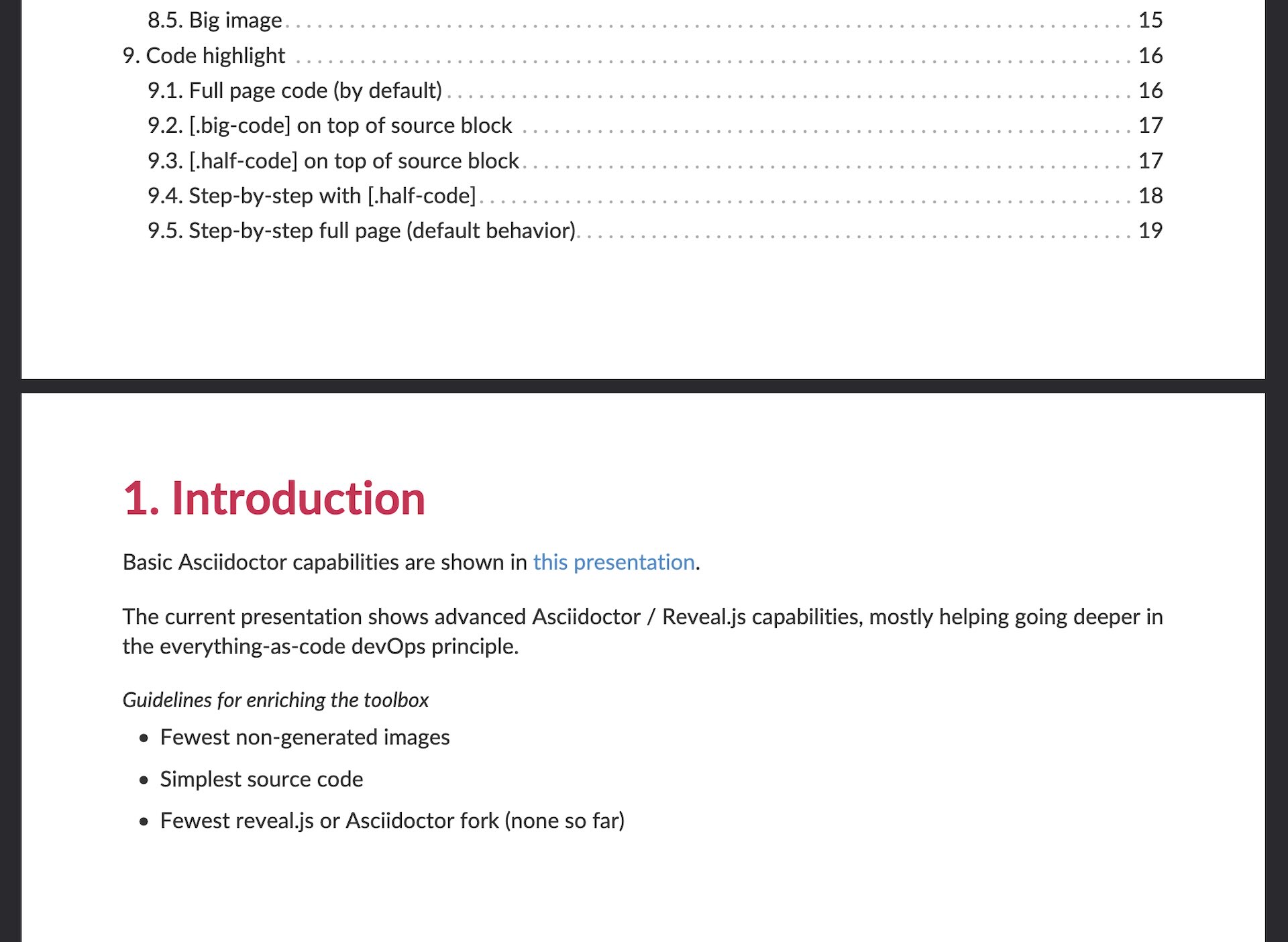This is a live documentation generation stack, used for some Zenika training material. It is based on Asciidoc and/or Markdown. It is a mono-repository including both framework and documents.
0% knownledge in HTML/CSS/JS is required to produce/update a document, and still being able to include advanced capabilities. Guides are provided, see hosted content above.
|
Warning
|
MS Windows generation files are not actively maintained and tested |
Basic Asciidoc syntax and Advanced Reveal.js capabilities generated examples are hosted on GitLab pages.
Light theme slides |
Dark theme slides |
Plain HTML |
|
-
Generate reveal.js, HTML and PDF documents from the same source without much care of the output type as a writer
-
All features of Asciidoc implemented by Asciidoctor and transposed to hosted Reveal.js presentations containing associated HTML and PDF links
-
All features of Asciidoctor-reveal which implements most features of reveal.js, especially step-by-step code highlighting
-
Basic Markdown features
-
All useful reveal.js plugins known to date (please contribute or advise if a key plugin is missing)
-
Some C3JS (D3JS) chart-as-code addons (for Reveal.js & HTML only) for dynamic and interactive charts
-
PlantUML diagrams with custom colors
-
Other "as-code" addons oriented toward Reveal.js presentations
-
Reveal.js themes are designed to be able to display any content (when reasonable sections size)
-
There are light and dark Reveal.js themes switchable in-presentation with no awareness needed while writing documentation. All colors are designed to fit both, especially PlantUML colors
-
Support for Linux, MacOS and Windows
-
There is a single generate.sh script for Linux/MacOS and generate.bat script for Windows to generate everything
-
Generation uses Docker and is based on docker-asciidoctor image. A slightly modified version, to have an edge version of asciidoctor-reveal
-
The script provides a way to live-reload generated content on modifications
-
Using GitLab pipelines, result is generated and hosted on GitLab pages per branch using the GitLab cache mechanism
You can use generate.sh on Linux & MacOS (M1 supported) and generate.bat on Windows.
./generate.sh [all|<category/subject>] [all|html|reveal|pdf|zip] [live]-
Optional parameter 1 is the documents scope of the generation
-
allto generate all documents -
<category/subject>is a 2 folders deep path to documents (all documents must match this layout)
-
-
Optional parameter 2 is the type of document
-
reveal,html,pdf,ziporall
-
-
Optional parameter 3 is
livefor live-reload in your favorite web browser
# generate html version of devops/kubernetes-user documents
./generate.sh devops/kubernetes-user html
# generate everything for every documents
./generate.sh
# equivalent to
./generate.sh all allSlides, HTML and PDF are generated in build-docs folder. Target folder is cleaned each time to ensure update of generated content.
|
Note
|
This script is also used by CI |
generate.sh provides a live reload solution based on inotifywait on Unix environment:
-
Install
inotify-tools
sudo apt-get install inotify-tools-
Generate at least once for the server to have files to serve
./generate.sh devops/kubernetes-user reveal-
Start a http server
cd build-docs
python3 -m http.server-
In another terminal, launch live reload mode
./generate.sh devops/kubernetes-user reveal liveYou can now browse files from local server, for example http://localhost:8000/kubernetes-user.htm. Files are automatically refreshed in your browser, thanks to a JS script included in generated HTML.
|
Note
|
No Asciidoc built-in live reload for now, documentation present some alternatives but not for Reveal.js. Some other solutions involve VS Code extensions or Ruby in an open issue. |
You can simulate a basic continuous regeneration every 5 seconds with this code running under any windows console (Windows or Windows+R and then type “cmd” and validate)
for /l %g in () do @(<ANY COMMAND> & timeout /t 5)
# In our case :
for /l %g in () do @(generate agile\kanban-1j reveal & timeout /t 5)This stack is more for new documents for people preferring Asciidoc. But an actual Markdown document can be migrated pretty fast.
|
Tip
|
For small text blocks there are online translation tools such as https://markdown2asciidoc.com/ |
Careful with | often not handled correctly if not in tables. Modify them first.
Ex: Pull|Merge changed to Pull/Merge
Use preferably Kramdoc.
Although pandoc can also be used, kramdoc gives better results.
sudo apt-get install ruby-full rename
sudo gem install kramdown-asciidockramdoc --output=getting-started.adoc --imagesdir=ressources --lazy-ids --heading-offset=1 --wrap=ventilate getting-started.mdfind ./ -name "*.md" -type f -exec sh -c 'kramdoc --imagesdir=ressources --lazy-ids --heading-offset=1 --wrap=ventilate --output=_includes/{}.adoc {}' \;find _includes -type f -name "*.adoc" -exec rename s/".md"/""/g {} \;-
Delete agenda if any (use Table of Content, see examples)
-
Replace in every .adoc files (VS Code regex style)
| regex | from | to |
|---|---|---|
yes |
|
<delete> |
no |
|
<delete> |
no |
|
<delete> |
yes |
|
<delete> |
yes |
|
<delete> |
yes |
|
<delete> |
yes |
|
|
yes |
|
|
yes |
|
|
yes |
|
|
no |
|
|
no |
|
|
no |
|
|
no |
|
|
no |
|
|
-
Update links to chapters from numbers to cross references
TLDR; standard Markdown is too poor as a lightweight markup language, and needs too many addons and custom development to fit HTML, Reveal.js and PDF.
Some elaborated articles :
The current stack has been gathered and maintained by a single person in his spare time. Almost no development needed. this is hardly possible on markdown stacks with the same features coverage.
-
Simplicity : To ease core modifications and generation in a single MR
-
Modularity : To allow include in documents from one to another
There is no particular reason.
You don’t like the result ? It’s perfectly fine. You can change basic things like slide transition and background in-presentation. But, most important, you can contribute with any Reveal.js CSS you find/produce that fits your presentation style, just add it in the appropriate folder and import it at the beginning of your presentation.
Here is a list of nice Asciidoc-based Reveal.js slide decks, for inspiration :



